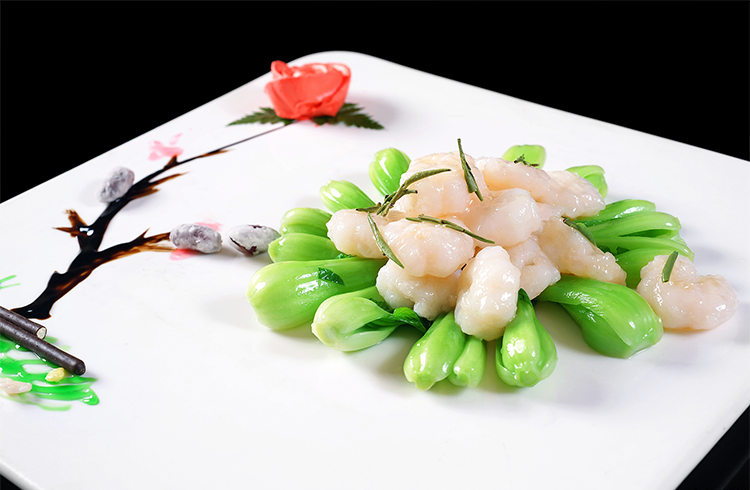Hangzhou Legend: Longjing Shrimp
1. Origin and Legend: A Literati Springtime Delight
Longjing Shrimp is inseparable from Hangzhou’s deep tea culture. One story says the Qianlong Emperor once tasted fresh Longjing tea in Longjing Village and the kitchen accidentally added tea leaves while frying shrimp — the pairing proved spectacular. Another explanation traces the dish to Song dynasty tea-and-feast customs in Lin’an (today’s Hangzhou), when new tea and seasonal river shrimp were celebrated together. Either way, the dish reflects Jiangnan refined taste: culinary precision paired with poetic elegance.

2. Cultural Meaning: West Lake Poetry on a Plate
In Hangzhou, the dish goes beyond food. Jade-white shrimp speckled with green Longjing leaves evoke the reflective beauty of West Lake. Its delicate flavor fits Jiangnan’s restrained cultural temperament. Served at formal banquets, Longjing Shrimp symbolizes refined hospitality and the local philosophy of combining tea and cuisine. At the 2016 G20 summit in Hangzhou, it appeared on state menus, showcasing Chinese aesthetic balance of color, aroma, and taste.

3. Choosing Ingredients: Spring Tea Meets Fresh River Shrimp
Authentic Longjing Shrimp depends on seasonality and freshness:
- Shrimp: live river shrimp from the West Lake watershed, typically small (about 120–150 per jin), peeled by hand to a translucent finish.
- Tea: Shifeng Longjing tea harvested before Qingming for the most tender buds and highest amino acids.
- Cooking oil: a seasoned rice wine oil derived from Shaoxing huadiao adds depth.
- Thickener: a light starch from Taihu region keeps the sauce clear and glossy.

4. Technique: The Art of the Eighteen-Second Stir-Fry
Mastering temperature and timing is crucial:
① Peel fresh shrimp after chilling, leaving the tail for presentation.
② Rinse Longjing leaves; steep at 80°C for 45 seconds and reserve the second infusion.
③ Coat shrimp lightly with starch and swiftly fry in 160°C oil for 18 seconds, then remove.
④ Mix tea infusion with starch to form a glaze; toss with shrimp for 5 seconds so tea aroma clings.
⑤ Finish by sprinkling rehydrated tea buds over the dish so every shrimp carries tea fragrance.

5. Flavor Layers: A Threefold Taste Experience
The first bite delivers springy, sweet shrimp; then the nutty and floral notes of Longjing tea unfold; finally a faint bitter-sweet tea finish lingers. This fresh–fragrant–sweet progression tastes like drinking an edible tea broth. High-quality Longjing Shrimp has clear sauce, firm jade-white shrimp, and a delicate resistance when bitten — the hallmark of live, fresh shrimp.

6. How to Eat It: Rituals of a Jiangnan Banquet
Traditionally served as the third hot course, Longjing Shrimp arrives when appetites are warmed and guests can best appreciate its subtlety. Use a white porcelain spoon to enjoy both shrimp and sauce, first inhaling the tea aroma, then tasting the shrimp. Pair it with ten-year Shaoxing huadiao rice wine for amplified flavors, or enjoy it with a bowl of Longjing tea-infused rice to extend the tea experience.

7. Where and When to Try It: A Local Must-Taste
- Best season: March–May (new tea after Qingming; shrimp at peak size)
- Recommended historic restaurants: Hangzhou Restaurant (Yan’an Road), Lou Wai Lou (Gushan Road)
- Ordering tip: choose portions priced per person for a refined presentation (typically ¥68–108 per person)
- Quality check: the tea aroma should be delicate, without harshness; shrimp should not feel icy.

8. Traveler Tips: Unlocking an Authentic Experience
① Visit Meijiawu tea village and taste farm-made Longjing Shrimp at local tea houses.
② Ask whether the dish uses “fresh-peeled river shrimp” — frozen shrimp lack the same texture.
③ During spring tea festivals, many restaurants offer limited-edition Longjing Shrimp menus.
④ Avoid delivery when possible: the tea aroma and texture are best enjoyed freshly stir-fried.

9. Home Version: Easy Tea-Scented Shrimp Recipe
Simplified ingredients: 300g fresh shrimp, 2 Longjing tea bags, 1 tablespoon starch.
Steps:
① Marinate peeled shrimp with egg white for 10 minutes.
② Steep tea bags in hot water 2 minutes and reserve tea.
③ Blanch shrimp 30 seconds and drain.
④ Thicken tea with starch, heat to boil, then toss shrimp quickly to coat.
⑤ Garnish with rehydrated tea leaves.
Tip: tea bags make concentration easier to control and prevent bitterness.

10. Summary
Longjing Shrimp is Hangzhou’s flavorful emblem and a refined experience spanning centuries. Combining the clarity of Longjing tea and the sweetness of fresh river shrimp, it captures Jiangnan elegance in every bite. When you stroll West Lake, seek a freshly stir-fried plate — it’s the most poetic way to taste Hangzhou’s spring.


